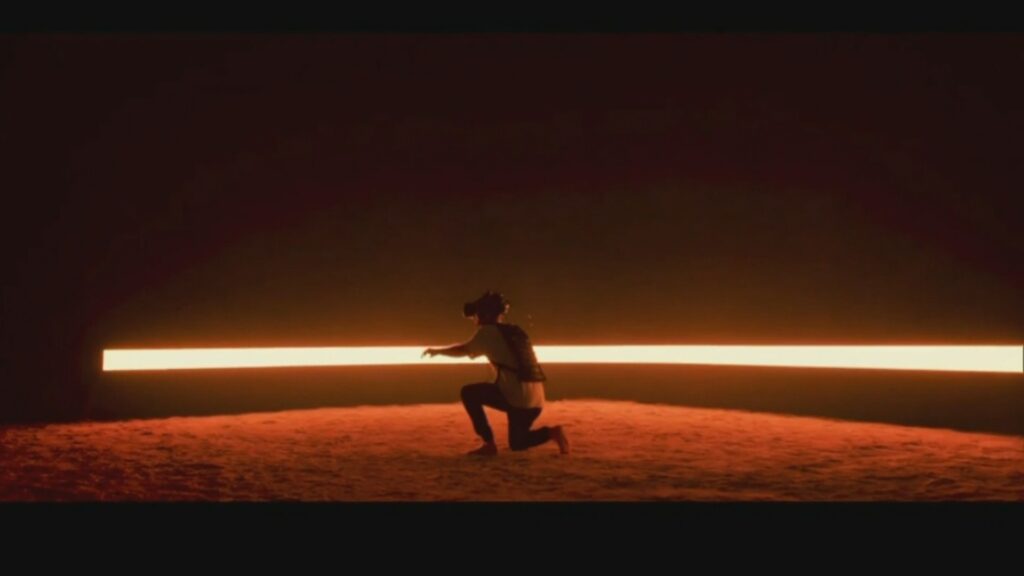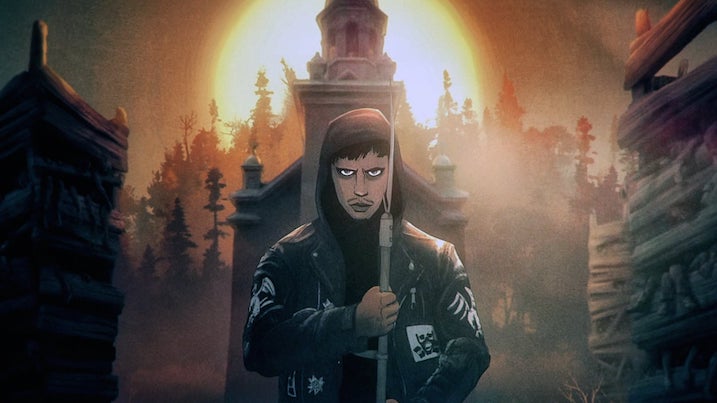Crafting Care through Text and Subtitles: A Deleuzian Perspective on Interactive Storytelling through Sensory Experiences
This presentation is part of the #IFM2023Conference – published in the Interactive Film & Media Journal, 3 (2). https://doi.org/10.32920/ifmj.v3i2.1788
This paper’s presentation investigates the underappreciated yet integral role of text, subtitles, and intertitles in the realms of interactive films and multimedia storytelling, employing a unique lens of craft, collaboration, and care. Drawing from Gilles Deleuze’s notion of the ‘speech-act’ and The Care Collective’s interpretation of care, the study explores the use of written text as a tool that guides the narrative widens accessibility, and promotes justice and equity in viewing experiences.
The complexity of the subtitling process, going beyond mere translation, is highlighted. Delving into Deleuze’s concept of ‘scriptual’, the paper outlines how reading subtitles adds a layer of abstract universality to films, demanding more than passive consumption from viewers. Analyzing the dynamics and impacts of subtitles in interactive films underscores their critical role in shaping viewer comprehension and perception.
The exploration of five interactive projects – “4Stelle Hotel” (2014), “Life on Hold” (2015), “The Displaced” (2015), “Sea Prayer” (2018), and “Another Dream” (2019) – offers concrete illustrations of how subtitles and intertitles contribute to creating sensory, caring, and emotional experiences, facilitating viewer engagement and understanding. By enhancing navigation and narrativity, this paper argues that subtitles and text can nurture a culture of care, aligning with the principles of The Care Manifesto.
The conclusion focuses on the effect and sensation in relation to written text and subtitles. Recognizing viewer agency in interpreting narrative, it emphasizes the potential of text and subtitles to catalyze dialogue, shared experiences, and a sense of care and connection among viewers. The paper further underscores the role of subtitles and intertitles as conduits, amplifying audiences’ sensory and emotional experiences and fostering a deeper understanding of characters, cultural nuances, and broader social, cultural, and political realities. The potential of these interactive experiences to stimulate political engagement is also discussed, marking a new benchmark in the cinematic experience.
In summary, this study underscores the significance of integrating text and subtitles in interactive film projects, accentuating their capacity to foster inclusivity, collaboration, and care within the narrative. It presents a compelling case for filmmakers and media professionals to design text and subtitle systems that enrich the viewing experience, disrupt uncaring societal structures, and, ultimately, contribute to a more empathetic and inclusive world.
Reframing Refugee Characters: Empathy and Agency in Interactive Narratives
In Interactive Film and Media Journal, v.3, n.1, Winter 3, pp. 33-42.
By allowing viewers to interact with stories, interactive films have revolutionized how viewers engage with social issues and events. The emergence of immersive technologies and interactive storytelling has transformed traditional storytelling forms and methods. These technological advances have rendered interactive storytelling more complex by challenging users to reexamine their understanding of the mediated world. Consequently, basic media literacy skills are necessary to benefit from these projects dealing with refugees’ stories.
Although interactive storytelling creates new forms of social engagement, the question of which social issues or subjects are most effectively addressed through interactive narratives remains. How do refugee stories and discourses contribute to interactive engagement? This essay analyzes a series of interactive projects focusing on refugees’ storytelling, politics, and aesthetics in order to examine their socio-political engagement and their unique attributes. Refugee stories hold a strong emotional appeal, positioning them as ideal for interactive narratives. How do unique refugee experiences of displacement and disarray engage creators and viewers/users/players?
This essay argues that refugee storytelling interactivity contributes significantly to viewers’ engagement with social issues and characters. While creating empathy and responsibility, these projects allow users to connect with people far removed from their own lived experiences. Characters with well-known and reliable stories make users feel closer in the position of moral concern to their situation and can instigate political accountability for their future. In interactive narratives, refugee characters redefine agency and storytelling. They offer the ability to recreate history, engender a change in the world, or revise a topic with a sense of justice toward dependable and trustworthy characters.
Political Engagement in Carne y Arena by Alejandro González Iñárritu: Subordinating VR Technology to Refugees’ Human Conditions
In Interactive Film and Media Journal, v.2, n.3, Summer 22, pp. 56-75.
Created by Mexican-awarded director Alejandro González Iñárritu, Carne y Arena is an immersive mixed-reality installation that allows visitors to experience traumatic and violent incidents with illegal immigrants crossing the Mexican–US border. Carne y Arena’s Mixed reality combines VR experience with physical components, turning it into a multisensory, bodily immersive experience. As part of the art installation, the whole VR arena is surrounded by the remains of a border, while inside, actual immigrants and objects are also exhibited. Another component is the documentary aspect, where real-life characters recount their stories through video testimonies.
Iñárritu immerses and make the visitors experience refugees’ stories first-hand while exploring their emotional reactions to traumatic realities through a spiral of corporeal sensations and entertainment spectacle.
According to Iñárritu, the intent is to subordinate technology to the human condition. Technology does mean nothing unless it can reveal or denounce people’s situations. Therefore, technology must be subordinated to humans, humanity, and art. “I despise technology,” says the filmmaker. But, has film lost the power to engage the viewers emotionally? Can virtual reality simulate refugees’ dispossession (the sense of the self) and alleviate society’s consciousness? In this paper, I examine the role of a museum installation featuring discourses and VR technology in bringing forward social engagement and the issues the filmmaker addresses, such as the refugee experience in contemporary global society.
Hollywood’s Viral Outbreaks and Pandemics: Horror, Fantasy, and the Political Entertainment of Film Genres
In Légua & Meia v. 13 n. 1, January 2022, pp. 97-129
Films revolving around big natural catastrophes, the end of the world, and global pandemics are viral in Hollywood. Some authors claim that 9/11 enticed the proliferation of disasters, zombies, and apocalyptical narratives. Will the coronavirus further increase these narrative tropes?
A cinematic apocalypse takes many shapes, including zombie infestation, nuclear war devastation, and aliens’ attack. Watching films such as Twelve Monkeys (1995), Children of Men (2006), or Contagion (2011) during a real-life global pandemic creates a much different viewing experience than when these films were released. Certain films kill humans with a deadly virus and turn them into zombies emphasizing and pushing forward to a cinema of genre its entertainment features, such as I Am Legend (2007), Train to Busan (2016), or Blood Quantum (2020). However, they also use horror, science fiction, and fantasy genres to portray a realistic compelling family drama or discuss structural racism and systemic colonialism against America’s indigenous peoples.
In all these films, scientific ambition, political greed, and economic power intermingle, becoming the unknown forces and real detractors behind these catastrophes. Whether or not the end of the world is an appropriate story for entertainment attracts most viewers to Hollywood cinema. Conventional postapocalyptic tropes create a film riddled with relevant political concerns. Every year, hundreds of films transpose to the screen compelling narratives related to pandemics and their effects. In Coronavirus’s times, I analyze and contextualize several of Hollywood’s viral outbreaks to situate their narratives to current political subjects and understand how disaster and pandemic films have become entertaining.

Zumthor et la voix poétique dans le Cinema Novo de Glauber Rocha et Vladimir Carvalho
In Paul Zumthor: Memória das Vozes. Ed. by Luiz Assunção e Beliza Aurea de Arruda Mello. São Paulo, Arché/Assimetria, 2018, pp. 139-167.
Le médiéviste Paul Zumthor a amplement étudié les racines et l’influence de la culture orale dans la société contemporaine. Ses recherches sur l’oralité nous permettent de mieux comprendre certains aspects de la littérature populaire de Cordel ainsi que le cinéma brésilien, puisque la présence et performance de la voix sont une des caractéristiques fondamentales du Cinema Novo.
La littérature de Cordel fut plus qu’une source d’inspiration pour Cinema Novo, ce fut un terrain de négociation identitaire nationale. En s’appropriant ses caractéristiques particulières d’une racine orale traditionnelle et amplement ancrée dans l’imaginaire brésilien, le mouvement de jeunes cinéastes intellectuels et politisés a pu crée un lien fort et direct avec la culture populaire brésilienne.

O cinema intercultural na era da globalização
In Cinema, Globalização e Interculturalidade, Denilson Lopes and Andréa França, eds. Chapecó, Argos Editora, 2010, pp. 43-66.
Nunca se viu tantos deslocamentos humanos quanto no século 20. A Segunda Guerra mundial provocou uma nova experiência do movimento de populações que se tornou uma das mais significativas e traumáticas dos últimos tempos. O mapa mundial foi retraçado e muitas culturas foram dispersas ou transferidas de uma região à outra. Nosso tempo é sem dúvida a era dos refugiados, das pessoas em movimento, da imigração em massa. Muitos artistas transformam os traumas do deslocamento numa importante renovação do pensamento e de reflexão sobre a sociedade contemporânea. Novas impressões e pontos de vista são criados com o descer e subir de barreiras, muros e alfândegas. Novas geografias e linguagens são impostas à um conjunto inteiro de culturas e antigas nações. Como aproximar o cinema às novas realidades e subjetividades dessas novas fronteiras?

Subtitling Jia Zhangke’s Films: Intermediality, Digital Technology, and the Varieties of Foreignness in Global Cinema
In Global Media, Culture, and Identity: Theory, Cases, and Approaches, Rohit Chopra and Radhika Gajjala, eds. London/New York, Routledge, 2011, 188-202.
Globalization, subtitles, and new technical filming devices bring new possibilities to contemporary Chinese cinema. This potentiality is revealed in the work of Jia Zhangke, through intermediality, which examines the imposition of technology and industrialization on contemporary Chinese society, two phenomena that cause the alienation and estrangement of Chinese people. This paradoxical result, expressed through Jia’s characters, is central to his films, such as The World, Still Life, Dong, Useless and 24 City, that focus on the isolation of transplanted individuals in urban settings and the breakdown of community.
L’expression de l’irrationnel. La parole en acte de la diaspora africaine dans trois documentaires brésiliens
In CinémAction ed. 163, Paris, June 2017, pp. 134-142
L’acte de parole dans le documentaire est un discours d’un sujet « en action » qui interagit avec son entourage et marqué par des tensions. Dans trois documentaires brésiliens, Le fil de la mémoire, Estamira et Ce que la terre a donné, la terre le reprend, on trouve de telles tensions chez trois personnages noirs qui voient l’histoire brésilienne sous un angle particulier. Par le biais de discours historiques et mythiques, de prophéties et de fantasmagories, ces personnages expriment leurs pensées intimes dans un effort pour révéler leur vision du monde. Ces trois discours différents réintègrent dans la société brésilienne d’une manière non-conventionnelle, voire subversive, l’héritage africain dont ils ont fortement conscience et qu’ils ne manquent pas de rappeler à ceux qui les écoutent. Cependant, ces trois films en documentant ces actes de paroles irraisonnées, légitiment toute en discréditant la validité même d’un discours afro-brésilien.
Par le fait de cadrer des personnages noirs au centre de l’image et de leur donner le rôle de narrateur de ces histoires, ces documentaires tentent d’évaluer la position et le discours des Noirs dans la société contemporaine, voire le discours de la société sur les Noirs. Dans l’un ou l’autre cas, il s’agit d’un ‘tour de force’ car ces films montrent la discrimination à l’égard des Noirs, leur aliénation, et leur marginalisation, tout en transformant leur faiblesse (rendue par un discours irraisonné et fragmentaire), une force en termes de document filmique pour révéler la vérité. Cependant, le film documentaire n’est pas réduit à enregistrer des vérités et des souvenirs inaccessibles. Il possède aussi une dimension réflexive qui questionne son pouvoir véridictoire. Pourtant, ces mêmes documentaires ont pour but de critiquer la stigmatisation de la maladie mentale et l’indifférence de la société à leur égard et à leur histoire diasporique.
Great Directors: Nelson Pereira dos Santos
In Senses of Cinema, Issue 60.
Nelson Pereira dos Santos (1928-2018), considered the initiator of modern Brazilian cinema in the 1950s, is also its most literary filmmaker. In fact, of his 25 features, 15 were based on literary work from Brazilian writers. This has assured him a privileged place as a member of the prestigious Brazilian Academy of Letters; never before has a Brazilian filmmaker been immortalized in this way. Santos is one of the most influential Brazilian filmmakers. In his quintessential career, his films have influenced directors and cinephiles for over 50 years. Of the most influential Brazilian films of the past five decades, at least one was directed by Santos in each decade. These influential films include Rio, 40 Graus (Rio, 100 Degrees F., 1955), Vidas Secas (Barren Lives, 1963), Como Era Gostoso o MeuFrancês (How Tasty Was My Little Frenchman, 1971), Memórias do Cárcere (1984), and Casa-Grande e Senzala (2000). Santos’ impact on Latin American cinema cannot be overstated. For critics and cinephiles all over the world, Santos’ early films are milestones in the emergence of modern post-war cinema. Inspired by neorealism, his films from the 1950s and 1960s depict the brutal reality of life in the favelados (slums)found in cities such as Rio de Janeiro, or of retirantes (migrants) fleeing the famine in the drought-stricken northeastern region of Brazil.




















